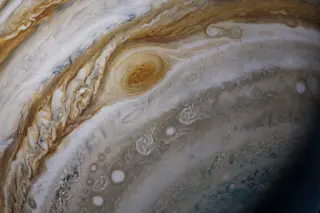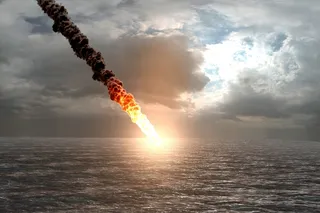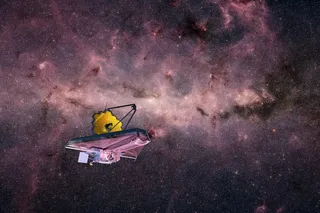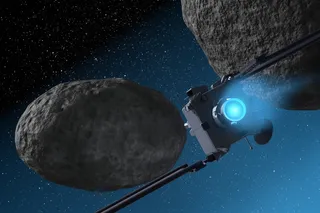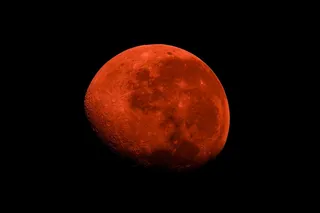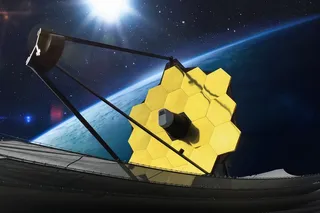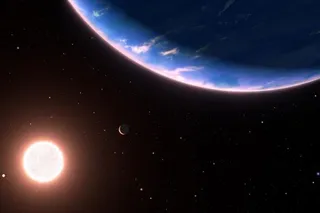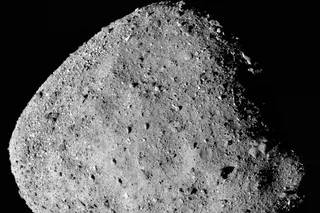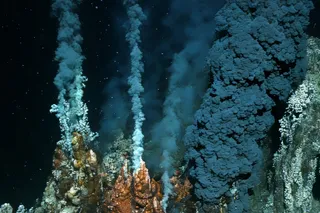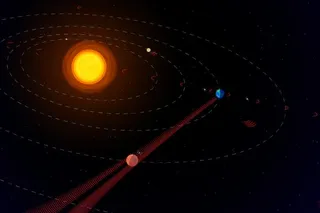Earth’s atmosphere is in such constant flux that we have a tired old saying about it: “If you don’t like the weather, wait five minutes.” If we lived on Jupiter — where a single storm has been raging uninterrupted for almost two centuries, and possibly much longer — we’d have to muster more patience.
But perhaps we wouldn’t have to wait forever. The Great Red Spot, an enormous high-pressure system which astronomers have tracked regularly since the late 19th century, is steadily dwindling. In its heyday, at 25,500 miles across, it was large enough to engulf our planet three times over; now it hardly spans a single Earth.
As of January, based on the latest data from the Hubble Space Telescope, the spot measures just 8,700 miles across and 5,800 miles high (that is, latitudinally). That’s in line with a consistent, decades-old trend. And while it's unclear whether our solar system’s most famous planetary feature will ever vanish entirely, there’s no reason to think its decline will stop or reverse anytime soon.
“It is still shrinking,” says Amy Simon, a senior scientist at the NASA Goddard Space Flight Center. Like last year and the year before, “It's the smallest size we've ever measured it at. That’s definitely not changing.”
Why the Great Red Spot Is Shrinking
Robert Hooke and Giovanni Cassini, two of the leading astronomers in the 1600s, both noted spots on Jupiter’s surface that resemble the modern storm. But there’s a gap of many decades before the next recorded sighting, and no one has been able to prove whether those early scientists were looking at the same thing we see today.
Read More: Jupiter’s Moon Io Is Alive With Volcanic Activity, Despite Its Initial ‘Dead Moon’ Image
That means the first reliable observation comes from 1831, and consistent observation only began in 1878. At that time, the spot was not only much bigger, but also much more oblong, like a humongous oval. “At this very large size,” Simon says, “it's not really stable.”
In fact, that initial structure may be partly responsible for its shrinking. A storm's internal winds tend to make it rounder, as seen in satellite images of hurricanes on Earth. (The main difference between them and the Great Red Spot is that the latter is an anticyclone, a type of storm that forms in regions of high atmospheric pressure. Hurricanes, also known as tropical cyclones, form in low-pressure regions.)
In a similar way, the winds that rip around the spot — in excess of 400 miles per hour — may be whittling that unsustainable oval into a more durable shape. Indeed, its waist is the dimension that’s narrowing fastest.
Will the Great Red Spot Ever Disappear?
That said, no one is sure why the Great Red Spot has shrunk so drastically — or, for that matter, what lies ahead. Its fate depends on a panoply of complex meteorological mechanisms.
On Earth, storms can dissipate as they make landfall, or fall apart as they drift to different latitudes. But on a gas giant like Jupiter, there is no land, and Simon says the spot is locked in its current latitude by powerful east-west jet streams, “like a ball bearing rolling in a channel.” Those circumstances are largely responsible for its longevity.
It may, however, meet its maker in a different way: Intense external winds can shear the top off a storm, sapping it of its strength. And as it happens, just such winds buffet the Great Red Spot. Historically, the storm has been more than a match, but as it gets smaller, those winds could eventually prevail.
Read More: A Record-Setting Solar Storm Hit the Earth 14,300 Years Ago, According to Ancient Trees
It’s also unclear how the diminishing tempest will interact with lesser storms in its path, though Simon says that in recent years it appears to be absorbing them more easily. That could either weaken or strengthen the Great Red Spot, depending on which direction they’re spinning.
“Those are the sorts of things we're going to be monitoring over the next few years,” she says. But when — or even if — they’ll have a dramatic effect on the spot, “your guess is as good as mine. It could be 20 to 30 years, it could be 200 years.” Or, alternatively, the storm could settle into equilibrium at a stable size and outlive us all.
A Spot of Mystery Remains
Though scientists are learning more and more about the Great Red Spot, it remains enigmatic. In 2021, a study published in Science set its depth at about 300 miles, suggesting the roots of the vortex extend deeper than anticipated, below the storm’s cloud base. But the processes powering it are still poorly understood.
And size isn’t the only thing in flux. Its name notwithstanding, the spot has ranged in color over the years, displaying an ever-shifting mix of deep red, fiery orange and even pale beige. As with so much else, no one knows the source of these breathtaking hues. But one clue came in 2019, when researchers found a way to recreate the spot’s color spectrum in the lab. Based on their findings, it may be a product of atmospheric ammonia breaking down under solar radiation.
For the next official update on proportions, astronomers await the annual data delivery from Hubble, which will turn its lens toward Jupiter in November (though amateurs, most notably a Brit named Damian Peach, keep continuous tabs).
The Great Red Spot probably isn’t in imminent danger of disappearing, but weather on the outer planets can be notoriously fickle. Neptune’s Great Dark Spot, first spotted in 1989, vanished unexpectedly before the next scheduled observation in 1994.
If the granddaddy of all storms were to someday follow a similar road into oblivion, the view from Earth would lose some of its celestial magic. “Everybody grew up with a picture in some textbook somewhere of Jupiter with the Great Red Spot,” Simon says. “For it to suddenly be gone would just be strange.”
Read More: In With a Bang, Out With Ammonia: Saturn's Strange, 100-Year Storms
Article Sources
Our writers at Discovermagazine.com use peer-reviewed studies and high-quality sources for our articles, and our editors review for scientific accuracy and editorial standards. Review the sources used below for this article:
Britannica. Great Red Spot
The Astronomical Journal. Historical and Contemporary Trends in the Size, Drift, and Color of Jupiterʼs Great Red Spot
Amy Simon. A senior scientist at the NASA Goddard Space Flight Center
Britannica. Anticyclone
NASA. Hubble Shows Winds in Jupiter’s Great Red Spot Are Speeding Up
Weather.gov. Hurricane Facts
Structure. Microwave observations reveal the deep extent and structure of Jupiter’s atmospheric vortices
Damianpeach.com. Views of the Cosmos
NASA. Neptune Dark Spot



